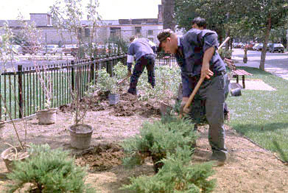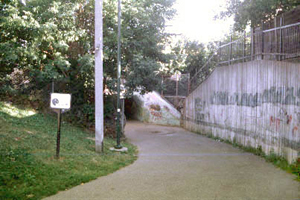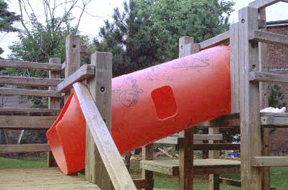A biweekly newsletter with public space news, resources, and opportunities.
A curated dispatch on all things public markets plus the latest announcements from the Market Cities Program.
Excerpted from Planning, Designing and Maintaining Safer Parks, produced by Toronto Parks & Recreation. This guide is not intended to be a definitive statement on creating safer parks and open spaces, nor is it intended to serve as a template for the design, operation and use of parks. See the Introduction for more information.
Overall, good maintenance plays a vital role in park safety. The presence of graffiti, litter, vandalism, poorly maintained paths or planting can contribute to a perception of lack of safety. They suggest that an area is uncared for, and has minimal supervision. If ignored, a cycle of abuse is likely to occur in which legitimate users start to avoid an area as physical conditions deteriorate. The result is that parks can be taken over by inappropriate users and uses.

Increased lighting, surveillance, maintenance and use of graffiti-resistant materials can decrease the occurrence and extent of graffiti, vandalism and inadvertent damage in a park. In turn, the area will project an image of being well cared for and users will feel safer. Generally, well-maintained areas enhance perceptions of security.
Management strategies also play an important role in park safety because certain approaches can establish a more visible parks staff presence. Most traditional maintenance operations do not generally encourage involvement between park users and parks staff, although greater interaction between them will put a more human face on parks and enhance other safety-related initiatives.
One strategy to accomplish this is the establishment of zone gardeners who work exclusively in a designated area or park. Their familiarity with the park provides greater awareness and sensitivity to potential safety problems. This system is being used in Central Park in New York City, where they have begun to replace their centralized management with a zone gardener system wherein staff are assigned responsibility for designated areas of the park.
To be more effective, staff should be trained in personal safety so that they know what to look for, who to report it to and when and how to intervene as well as how to respond to reports from the public about safety concerns.
What to consider:

Presence of Parks Staff
User Feedback
Reducing Vandalism and Graffiti

Vandalism breeds vandalism. A quick response to remove graffiti, replace damaged fixtures or remove garbage has been shown to greatly reduce the incentive to deface areas.
The conventional way to address vandalism is "incident oriented" - a problem is reported and parks staff respond by repairing the damage. While immediate repair is critically important, it should be combined with an effort to find out the source of problem, otherwise the incidents will probably continue.
Community Partnerships
Staff Involvement
Naturalized Areas
The rich text element allows you to create and format headings, paragraphs, blockquotes, images, and video all in one place instead of having to add and format them individually. Just double-click and easily create content.
The rich text element allows you to create and format headings, paragraphs, blockquotes, images, and video all in one place instead of having to add and format them individually. Just double-click and easily create content.
Body Text Body Link
The rich text element allows you to create and format headings, paragraphs, blockquotes, images, and video all in one place instead of having to add and format them individually. Just double-click and easily create content.
Here is some highlighted text from the article.




Headings, paragraphs, blockquotes, figures, images, and figure captions can all be styled after a class is added to the rich text element using the "When inside of" nested selector system.
Headings, paragraphs, blockquotes, figures, images, and figure captions can all be styled after a class is added to the rich text element using the "When inside of" nested selector system.
Headings, paragraphs, blockquotes, figures, images, and figure captions can all be styled after a class is added to the rich text element using the "When inside of" nested selector system.